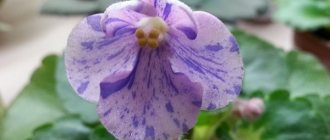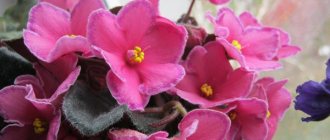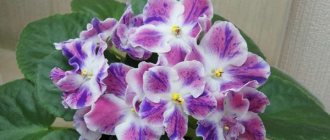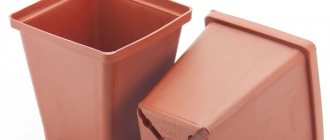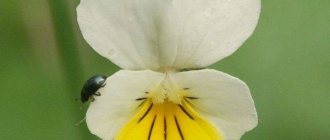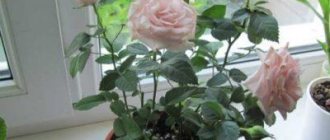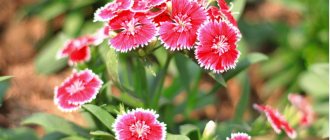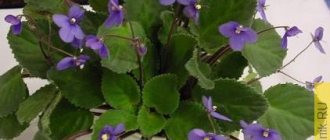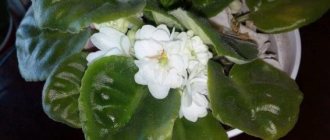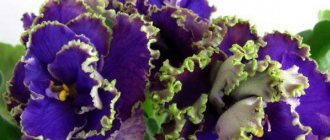Violet Apache Freedom (J. Munk)
Description and photo
This Saintpaulia has an even rosette and belongs to the standards . The leaf blade is wavy, corrugated, with white and pink Tommy Lowe variegation . The underside of the leaves is red.
The rosette is very harmonious, it looks beautiful, but if there is not enough lighting, it lifts the leaf plates up.
The shape of the flower varies between pansy and star, but since the petals are very wavy, it is quite difficult to determine the exact shape. In the author's description the flower is listed as pansy.
The flowers have two tones, a light pink bottom and a darker top. The petals can be colored purple, coral and burgundy or burgundy.
This variety attracts collectors with its unusually beautiful, large openwork rosette. It produces abundant flowering, but does not form a head; rather, it can be called a beautiful bouquet. It blooms quite rarely.
Most often, the variegation is white, but has a pinker color closer to the middle of the rosette.
It is valued more for its beautiful rosette ; to form it, it is worth placing on a rack. But you shouldn’t expect violets to bloom in such conditions. In order for the rosette to produce flower stalks, it should be given good lighting for at least 10-12 hours a day.
To form beautiful variegated foliage, violets must be kept in cooler conditions . Most often, at least 18 months pass from rooting of a leaf to the first full flowering.
Sports varieties may appear as irregularly shaped flowers or white fragments on the petals. Also, a genetic mutation manifests itself as the absence of a darker border along the petals.
Violet LF-Daria (L. Fedoseeva)
Bright violet LF-Daria.
Genus, family
"Daria" is an Uzambara violet, from the Gesneriev family .
History of the variety, who is the breeder?
Since ancient times, violets have conquered their:
- Amazing beauty;
- And rich green foliage.
Now violets have not lost their popularity at all, but on the contrary, every year breeders develop many beautiful varieties that people fall in love with at first sight.
Lilia Fedoseeva began to get interested in growing violets at a young age, at 15 years old . Now she is one of the famous Russian breeders.
She herself comes from Pyatigorsk , Stavropol Territory. Every year she successfully presents new varieties at domestic selection exhibitions, the “Daria” variety is new in 2017.
Photo and description of the variety
LF-Daria is a fantastic violet, one of the most recognizable from the standard class , thanks to its unusual colors. Flowers have:
- Dark crimson shade;
- They are decorated with a stunning pink ruffle.
Amazing color of raspberry-coral, simply fantastic curly flowers, an ideal addition to any collection.
itself :
- Very curly;
- Grows quickly;
- Propagates well from leaf cuttings;
- At the same time, they do not skimp on children and they appear very quickly.
The variety grows and develops very well.
Therefore, if you have not yet become acquainted with this violet, then be sure to purchase a pot with a young shoot of this variety. And the amazing unusual ruffled and bright flowers, purple with a pink border and coating, will win your heart.
Important! LF-Daria always wants to bloom, even at the peak of the summer heat it produces many flower stalks.
The foliage of the LF-Daria variety is rich green and smooth.
Home care
The violet should be placed in a cool and well-lit place. But if the leaf plates in the center of the rosette begin to curl, it means there is too much light. If the violet is very dark, it begins to stretch upward or pull out cuttings and flower stalks.
In cool weather, variegation appears more clearly and in greater quantity.
How to water and feed?
Tommy Lowe-type variegation is well transmitted from the mother leaf to the children, but in order for it to appear more clearly, you should not be zealous with nitrogen.
If the plant is kept on wick irrigation , then the fertilizer is given directly into the water. In the process of growing green mass, violets are given nitrogen compounds.
But it is worth considering that the rosette, like all variegated leaves, grows slowly and it is undesirable to accelerate development by any means . It will not bloom faster, and the appearance may deteriorate.
When it begins to produce flower stalks, the violet is given potassium and phosphorus. With proper care it will produce a lush and beautiful bouquet.
Important! You can also use folk remedies - fresh infusion of onion peels or citrus peels, tea leaves or coffee grounds. But you should not place the last two components on the soil surface - mold often settles on this biological waste, which is not needed in a pot with Saintpaulia.
Lighting and temperature
This Saintpaulia variety prefers good lighting and low temperatures. In such conditions, the rosette has a more beautiful appearance and produces buds.
Air humidity
Violet can be kept in normal room conditions, where the humidity level is kept within 55%. If the humidity is high, then favorable conditions are created on the surface of the leaves for the development of fungal infections.
Apache Freedom grows well in normal room humidity.
Soil Features
Saintpaulia prefers loose, light soil rich in humus. The soil should not retain water to prevent the roots from rotting. But you shouldn’t overdry the earthen ball either - Saintpaulia may die.
Pruning and hygiene
All old or yellowed leaves should be removed immediately. The same should be done with leaf blades on which suspicious brown or black spots have appeared. To prevent the fungus from spreading to the entire plant, the localization site is immediately removed. All violets that stand on the windowsill are treated for fungus and quarantined.
Despite the fact that many gardeners do not recommend wetting Saintpaulia leaves, it can be done if it is heavily soiled. The leaves are washed under warm running water with low pressure. After the hygienic procedure, the surface of the leaves should be thoroughly dried and only then placed in the sun. Otherwise, sunburn will appear on the surface.
Reproduction
Varietal characteristics are transferred from the mother leaf quite well. Therefore, the leaf plate is most often rooted.
The violet develops slowly, so don’t expect it to bloom quickly.
The leaf can be placed in water for rooting or immediately planted in moist soil. In the second case, it is worth putting the pot in a greenhouse.
Transplant rules, rejuvenation
Saintpaulia Apache Freedom develops very slowly and is in no hurry to age. But periodically it has to be rejuvenated:
- For this purpose, carefully cut off the head of the plant along with a small part of the trunk;
- Place the edge of the rosette in water for rooting. The trunk will give roots faster if you add special rooting fertilizers to the water;
- After this, the plant is planted in the soil.
If the rosette is not very old, then once every year and a half the soil is changed when replanting:
- Carefully remove the rosette from the pot;
- Remove about a third of the root system using pruning shears;
- Sprinkle the cuts with charcoal;
- After all procedures, the bush is planted in fresh soil.
Transplanting violets.
Features of cultivation
When caring for the Golden Lily violet, it is important to observe several points:
- The best places for growing Saintpaulia are window sills facing the east, southwest and northeast. In this case, the plant will have enough light, but direct sunlight will not pose a threat to it.
- The room temperature is maintained at 20-23 degrees and humidity at least 60 percent.
- Water the flowers as the earthen ball dries with warm water. During the period of active flowering, humidification is practiced through a tray filled with water.
- Flowers need regular feeding. It is better to use balanced complex formulations.
Although the Golden Lily violet can bloom throughout the year, it is better to provide a dormant period in winter. At the end of autumn, they select the moment when there are no buds on the plant or there are few of them, and move the flowerpots to a cool room and reduce watering.
Features of flowering, growth and reproduction
The violet develops slowly and for a long time. To grow a full-fledged rosette, you should wait at least a year and a half . This does not depend on the conditions of detention, it is simply a feature of the variety.
The variety is not prone to excessive formation of stepsons and is most often propagated using leaf cuttings. Before separating the baby from the leaf, you should wait until the green parts appear on the leaf plates.
Attention! The more green fragments, the higher the chances of survival and faster development.
Violet flowers are quite large - they reach a diameter of 6 cm.
Violet prefers coolness and good lighting.
Saintpaulia Apache Freedom does not produce a head of flowers, but a good bouquet can only be obtained with sufficient light.
Apache Freedom will bloom profusely only in good light.
At higher temperatures, the border along the edge of the sheet blurs slightly. Much of the variegation also disappears.
Violet blooms for a long time. The buds last for several weeks and do not fade. But flowering is not frequent.
Description of violet Golden Lily
Violet LE Golden Lily, a photo and description of which is given in the article, belongs to the hybrid Saintpaulia genus, which includes more than 20 subspecies. If we take into account the shape of the flowers and their color, the variety can also be classified as fancy or double, as well as yellow-flowered.
Important! In flower shops, violets are most often found under the name Golden Lily. But sometimes you can find such options as LE-The Golden Lily or LE-Zolotaya Liliya.
The main difference and advantage of the Golden Lily violet is its compact leaf rosette. Its leaves have petioles of 3-4 cm, and due to this they seem to rise above the flowerpot. The leaf blades themselves are medium in size, rounded with a slightly pointed nose and wavy edges. The surface of the fleshy, quilted leaves of the Golden Lily violet is a rich green color. There is slight pubescence.
Violet Golden Lily is quite demanding in terms of growing conditions. It requires compliance with the water regime, proper watering with warm, settled water and long daylight hours with plenty of diffused light. For active development and abundant flowering, the plant needs fertile, slightly oxidized or neutral soils. In addition, the flower needs frequent replanting.
Features of flowering
As the owners of Golden Lily violets note, the plant blooms almost all year round, with a short break in the winter. The flowers are mostly solitary. At the same time, from 4 to 10 buds bloom on the plant. The so-called “cap flowering”, beloved by flower growers, is difficult to achieve. But thanks to the large double and semi-double flowers, the violet looks very impressive.
